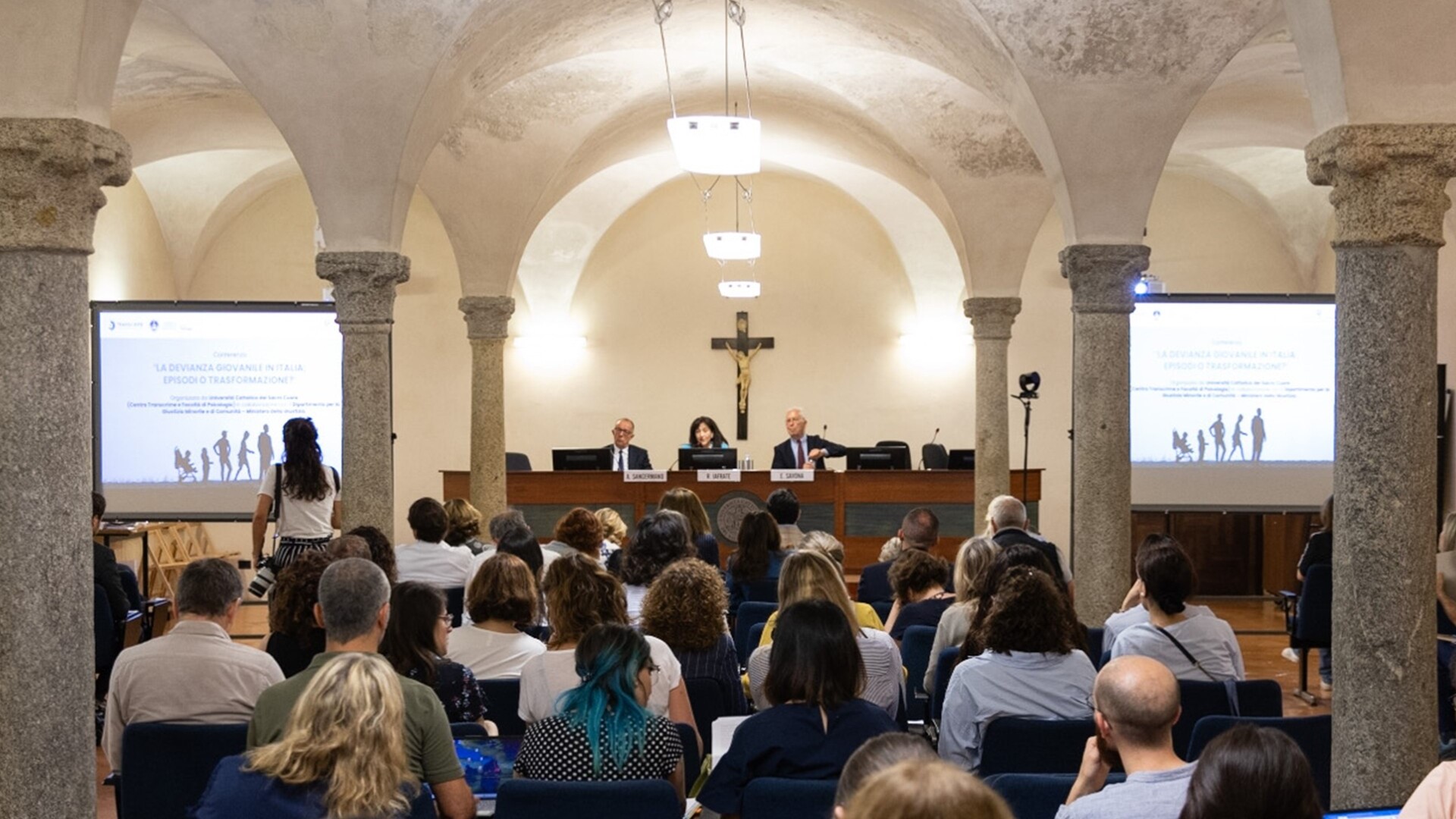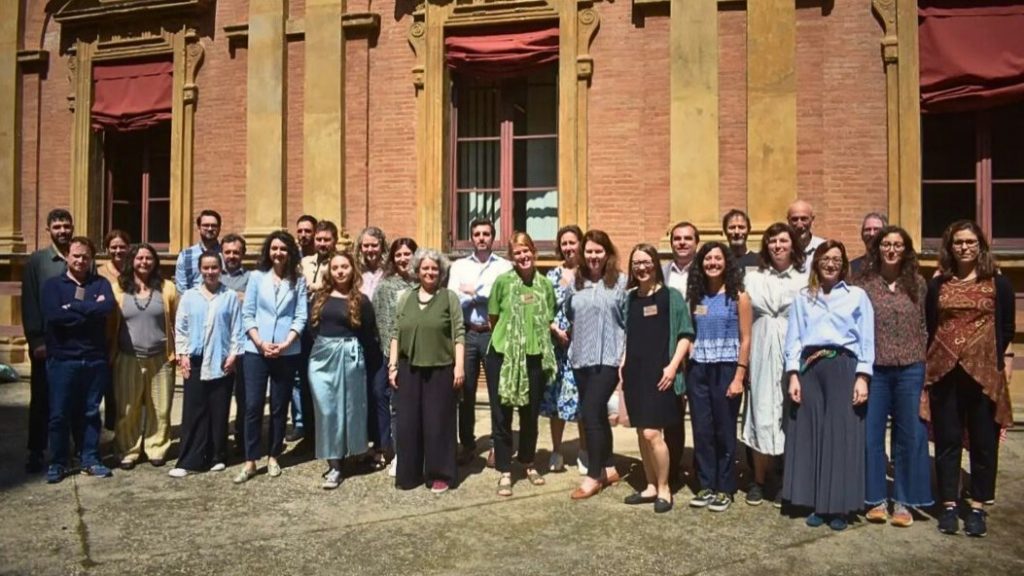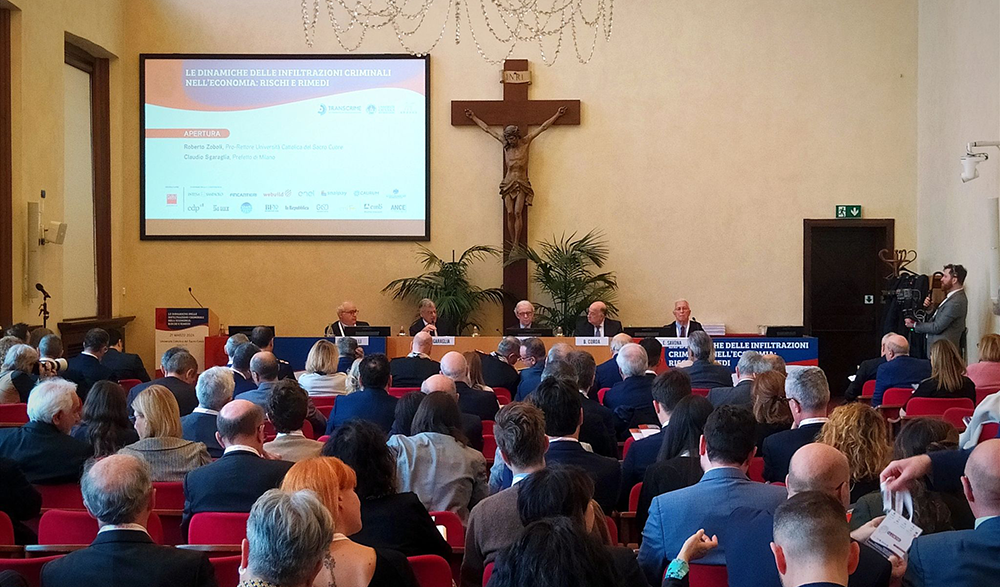Transcrime and Crime&tech at the XXIV ESC Annual Conference
European Society of Criminology 24th Conference: “Criminology goes East”
11-14 September 2024 – Bucharest, Romania
The Eurocrim Conference of the European Society of Criminology (ESC) represents one of the most prestigious events in the field, fostering dialogue at both European and global levels, driving innovation and collaboration among experts and researchers.
At the 24th edition of the ESC conference, Transcrime and Crime&tech researchers will once again be at the forefront: we will present our latest findings on issues ranging from organised and financial crime to crime prevention strategies, global trafficking trends, advanced data analysis techniques, and more. Explore the full agenda of our presentations below.
Register for the event on the official website. Full programme available here.
TRANSCRIME – CRIME&TECH SPEAKING AGENDA:
THURSDAY, Sept. 12
EUROC 10 Economic Crimes
8:00 to 9:15am. We present:
- Criminals, partners, or enablers? Making sense of lawyers’ involvement into economic crimes by mafia members in Italy (Author: Matteo Anastasio)
Click to read the abstract
Criminological theory states that mafia groups require a high degree of human and social capital to expand into non-traditional areas (Catino, 2018; Sciarrone, 2021). If they cannot find these resources internally, mafia members turn to external actors who operate within the so-called “grey area” as a transmission chain between the legal and illegal worlds. These actors are often professionals, and namely lawyers. There are several studies on the involvement of lawyers in economic crime, particularly in money laundering (Benson, 2020; Levi, 2022), but very few studies have so far investigated how lawyers facilitate criminal infiltration by mafia members in Northern Italy, and specifically (a) what resources they provide to mafia members and how they contribute to the accumulation of human and social capital by mafia members (b) what exchanges and agreements they make with mafia members, and (c) how and to what extent they participate in the criminal decision-making. These issues will be addressed through a script-network analysis of a dataset comprising cases of criminal infiltration by mafia groups into legitimate businesses in Northern Italy involving lawyers. The results are relevant both for understanding the participation and facilitation of economic crime by professionals and for evidence-informed policy making.
- International sanction circumvention techniques: key actors, jurisdictions and methods (Authors: Giovanni Nicolazzo, Matteo Anastasio, Caterina Paternoster, Laura Ventre, Giorgia Cascone, Francesco Venturini, Michele Riccardi).
Research carried out under the EU co-funded project KLEPTOTRACE.
Click to read the abstract
This study provides a qualitative analysis of mechanisms used to evade international sanctions, using legal documents, case studies, and global news aggregators as data sources. The objective is to reveal the transnational networks that companies use to circumvent international sanctions by transferring assets, layering beneficial ownership, and using crypto assets. The paper describes the methods used to evade international sanctions, outlining their operational features, key actors, assets, jurisdictions, and financial flows. By delineating sanction circumvention techniques, the paper contributes to the ongoing discourse on the effectiveness of international sanctions. The insights provided can assist policymakers, regulators, and academics in developing more effective strategies to combat such practices. The analysis is carried out under the project KLEPTOTRACE, co-funded by European Commission, ISF police.
WG Organized Crime and Criminal Networks Panel 1. Methods for studying organized crime
9:30 to 10:45am. We present:
- Leveraging open sources to understand illicit firearms trafficking in Europe: an exploratory analysis (Authors: Marina Mancuso, Caterina Paternoster)
Research carried out under the EU co-funded project CEASEFIRE.
Click to read the abstract
Numerous research works have underscored the effectiveness of open sources in scrutinizing various forms of criminal activity. Sophisticated data processing and crawling methods based on data and text mining techniques have demonstrated their utility in gathering information on diverse criminal events such as terrorism, human trafficking, and human smuggling. This includes insights into perpetrators, victims, and modi operandi, particularly concerning crimes where official data is limited or outdated.
Within the framework of the Horizon Europe CEASEFIRE Project (Advanced versatile artificial intelligence technologies and interconnected cross-sectoral fully operational national focal points for combating illicit firearms trafficking), this study proposed a methodology centered on open source data analysis for investigating illicit firearms trafficking across Europe. By leveraging open source data, the study examines incidents involving firearms (including seizures and selected firearm-related crimes) across EU Member States, where official data is often lacking and varied. This approach facilitates the acquisition of an updated intelligence picture of the phenomenon, potentially enhancing the ability to identify emerging trafficking trends and define reliable risk profiles.
- Artificial Intelligence for Researching and Investigating Organized Crime (Author: Ernesto U. Savona)
Click to read the abstract
The introduction of Artificial Intelligence in law enforcement has shown promise but concerns loom regarding its potential contributions to the proliferation and sophistication of crimes. This awareness brings the law enforcement community to a conclusion that the use of AI could be a benefit for criminals but also for law enforcement. This paper aims to delineate the potential benefits and limitations of leveraging generative AI in researching and investigating organized crime (OC) and financial crime. By exploring both aspects, law enforcement agencies can optimize their investigative efforts to develop strategic and tactical intelligence.
The conceptual framework employed aligns with the one developed by Transcrime for the UNODC and INEGI Center of Excellence in 2012(https://www.transcrime.it/wp-content/uploads/2014/05/CoE_MOC-in-Latin-America-and-the-Caribbean-Sept-2012.pdf) This framework encompasses five dimensions (Groups, Activities, State Response, Enablers, Civil Society Response) measurable through quantitative and qualitative data at Macro (territory), Meso (vehicle), and Micro (subjects) levels. The main assumption is that OC risks vary across different socio-economic contexts, organizational structures, and vulnerabilities, forming a basis that generative AI can utilize to map risks related to OC and financial crimes. Examples of the methodology and its implementation are provided.
Criminology of Mobility. Panel 2. Human trafficking trends and identification of victims
9:30 to 10:45am. We present:
- Unveiling the Dynamics of Trafficking in Human Beings: A European Perspective (Authors: Carlotta Carbone)
Research carried out under the EU co-funded project VANGUARD.
Click to read the abstract
Trafficking in Human Beings (THB) represents a complex transnational organised crime with various manifestations, including sexual and labour exploitation, alongside other forms such as forced criminality. It is a dynamic and continuously changing phenomenon, with perpetrators often operating within extensive criminal networks, leveraging societal, geopolitical and technological factors to their advantage. Notably, the digital realm has become a key arena for traffickers, who exploit online platforms to recruit and exploit victims, ushering in a new era of exploitation. Given its continuous evolution, it is crucial to promptly understand its dynamics to inform research and develop effective prevention strategies. This study delves into THB dynamics in Europe, specifically focusing on sex trafficking, labour trafficking and forced criminality. Drawing upon extensive literature reviews and insights from semi-structured interviews with THB experts, including law enforcement officials, border guards, and policymakers, it pursues two main objectives. Firstly, to elucidate the evolving landscape of THB by analysing the techniques employed across various stages of the crime and the involvement of criminal organisations, especially in light of emerging international threats such as the COVID-19 pandemic and global conflicts. Secondly, to identify the underlying factors contributing to individuals’ involvement in THB as either victims or perpetrators (i.e., vulnerabilities). The study presents the initial findings from the European-funded project VANGUARD (Grant Number 101121282). By addressing these objectives, the research endeavours to provide a comprehensive understanding of human trafficking dynamics and inform strategies for combating this pervasive crime.
- Breaking Down Labour Trafficking: Investigating Company and Victim-focused Risk Factors for Improved Detection (Authors: Francesco Calderoni, Clara Rondani, Michele Riccardi)
Research carried out under the EU co-funded project INVERT.
Click to read the abstract
In today’s capitalist economy, the exploitation of workers represents a tangible risk, facilitated by deregulation and flexibility of labour markets. Additionally, increased migration, due to conflicts or poverty in migrants’ home countries, creates a favourable condition for traffickers and exploiters who seek access to a cheap workforce, without the need to provide legal protection. In this context, proactively examining the risk factors embedded in the characteristics of labour supply and demand is essential for promptly identifying instances of exploitation. This paper will present the results of a preliminary analysis of the factors that are associated with increased risk of labour trafficking, based on national and international investigations and judicial decisions. The identified risk factors highlight the intricate nature of labour trafficking, which often involves legitimate companies and is connected to other types of corporate crimes and violations of labour laws. On the labour supply side, several victim-focused risk factors are identified to support professionals in detecting signs of exploitation during interactions with potential victims. The analysis, conducted within the EU co-funded INVERT project (GA 101101914), contributes to the development of a risk assessment model to support law enforcement agencies and prosecutors in identifying victims and companies potentially involved in labour trafficking.
EXTR2 Threat landscape and counter-terrorism1
1:00 to 2:15pm. We present:
- Identifying Threats and Vulnerabilities in Places of Worship (Authors: Marco Dugato, Carlotta Carbone, Ernesto U. Savona)
Research carried out under the EU co-funded project SHRINEs.
Click to read the abstract
This paper provides a detailed classification of threats and vulnerabilities characterising places of worship. It highlights the exposure of these venues to a spectrum of security threats, from attacks driven by religious or political motivations, including terrorism and hate crimes to crimes devoid of religious or political motives (e.g., theft, violence) or natural disasters (e.g., earthquakes, construction fails, pandemics like COVID-19). Further, the paper reasons of the main vulnerabilities that make places of worship particularly susceptible to specific risks. The paper leverages insights from a network of religious communities, law enforcement agencies, academic or security experts and public authorities. Additionally, case studies illustrating these threats and vulnerabilities identified through a systematic scraping of online news articles across EU MS are also presented. By exploring the key threats and vulnerabilities affecting places of worship, this study aims to provide a framework for developing effective strategies to enhance their security and safety. The results presented in this paper originate from the analysis conducted within the EU co-funded project SHRINEs.
Academic Publishing and Open Research in Criminology
2:30 to 3:45pm. Roundtable (David Buil-Gil, Kyle Treiber, Ernesto Savona, Emily Gray, Loraine Gelsthorpe, Matt Ashby)
POL Panel 25. Investigative challenges and legal practice: Pre-charge bail, the polygraph, waste crime and effective interviewing
2:30 to 3:45pm. We present:
- Improving Waste Crime Investigation Strategies (Authors: Serena Favarin, Giovanni Nicolazzo, Phillip William Screen)
Discover Crime&tech research on waste crime within the EU co-funded project EMERITUS.
Click to read the abstract
In most jurisdictions, waste crimes are considered to be lucrative activities with a relatively low risk of detection and prosecution. However, there is a scarcity of literature on waste crime investigations, resulting in a knowledge gap regarding effectiveness of enforcement strategies to address these offenses. The primary aim of our research is to propose a new approach for enhancing waste crime investigation endeavors.
Functional to this, we identified a sample of individuals who have been investigated or charged for various forms of waste crimes in Italy and systematically gathered information on all private companies associated with them. Subsequently, we conducted statistical analyses of the characteristics of these affiliated companies to identify potential indicators of illicit activities. These indicators are utilized to develop a risk model aimed at enhancing the identification of unlawful companies operating across different sectors. By elucidating the characteristics of these companies, we gain insights into the nature of the crimes committed and, consequently, refine appropriate investigation techniques. Once unlawful companies are identified, it is possible to target in-depth financial investigations and on-site controls using new technologies (e.g., drones, air-sensors) to uncover illegal waste management practices.
WG Organized Crime and Criminal Networks Panel 5: Organized crime: involvement, trajectories and vulnerabilities
2:30 to 3:45pm. We present:
- Violence transmission dynamics and organized crime involvement (Authors: Cecilia Meneghini, Francesco Calderoni)
Click to read the abstract
Previous research across various offending samples consistently suggests that co-offending can increase the probability of committing violent crimes in the future. However, while studies on general offenders attribute this phenomenon to mechanisms involving the internalization of violence—akin to epidemics where exposure to violent offenders leads individuals to adopt similar behaviors—research on organized crime offenders indicates the operation of distinct mechanisms. Specifically, among organized crime groups, co-offending appears to facilitate the transmission of violence without necessarily inducing the internalization of violent behavior as posited in earlier studies. Previous research across various offending samples consistently suggests that co-offending can increase the probability of committing violent crimes in the future. However, while studies on general offenders attribute this phenomenon to mechanisms involving the internalization of violence—akin to epidemics where exposure to violent offenders leads individuals to adopt similar behaviors—research on organized crime offenders indicates the operation of distinct mechanisms. Specifically, among organized crime groups, co-offending appears to facilitate the transmission of violence without necessarily inducing the internalization of violent behavior as posited in earlier studies. Previous research across various offending samples consistently suggests that co-offending can increase the probability of committing violent crimes in the future. However, while studies on general offenders attribute this phenomenon to mechanisms involving the internalization of violence—akin to epidemics where exposure to violent offenders leads individuals to adopt similar behaviors—research on organized crime offenders indicates the operation of distinct mechanisms. Specifically, among organized crime groups, co-offending appears to facilitate the transmission of violence without necessarily inducing the internalization of violent behavior as posited in earlier studies.
FRIDAY, Sept. 13
Drugs across borders: international research on drug trafficking networks
9:30 to 10:45am. We present:
- Expressway to illicit: an exploratory analysis of the misuse of the postal system for trafficking in drugs and other illicit goods (Authors: Michele Riccardi, Phillip William Screen)
Research carried out under the EU co-funded project PARSEC.
Click to read the abstract
As a result of the changing habits after Covid-19 and the expansion of e-commerce, the postal system is now playing a central role in international trade. However, it has also become more vulnerable to be misused for trafficking purposes. Letters, small parcels and courier consignments are increasingly employed to move drugs across borders (especially synthetic ones, but also cocaine, cannabis, opioids), drug precursors, firearms or their components, fake or stolen medicines, and counterfeit goods. This paper, conducted in the framework of the EU co-funded PARSEC project, has a twofold objective: on the one side, it provides a literature review of the most frequent patterns and schemes in trafficking through the postal service, and of the related risk factors; on the other side, it carries out an exploratory analysis of a large dataset of parcels and courier consignments sampled from the H7 database provided by a leading European custom authority. In particular, the paper analyses anomalies in terms of parcel distribution and concentration, and highlights the characteristics of the courier consignments used to conceal drugs and other illicit goods. It eventually develops a preliminary risk assessment model which could help custom and postal agencies to detect high-risk consignments to be selected for physical inspections.
Regulation and Enforcement of Corporate Financial Crime Across Europe
9:30 to 10:45am. Roundtable (Frederike Oberheim, Joras Ferwerda, Michele Riccardi)
EUROC 6 – Corruption and Public Institutions
2:00 to 3:15pm. We present:
- Modus Operandi of Corruption: Examining Drivers, Actors, and Financial Flows in Three Typologies (Authors: Caterina Paternoster, Matteo Anastasio, Giovanni Nicolazzo, Laura Ventre, Giorgia Cascone, Francesco Venturini, Michele Riccardi)
Research carried out under the EU co-funded project FALCON.
Click to read the abstract
The paper analyses the new forms and modi operandi of three typologies of corruption: public procurement corruption, border corruption, and conflicts of interest involving politically exposed persons. Based on the qualitative analysis of 50 cases drawn from judicial records and open-source media, the study identifies the key drivers, actors, and assets associated with each type of offence. The research uncovers the operational strategies of the corrupt practices, including the flow of funds and the jurisdictions involved in both the illicit enrichment and money laundering processes. The paper contributes to the current understanding of corruption in criminological discourse, while providing insights for policymakers and law enforcement agencies to combat such illicit activities. The paper is based on work and preliminary research carried out as part of the EU co-funded project FALCON, “Fighting Corruption & Organised Crime”.
EXTR7 Crime-terror nexus and terrorist networks
3:30 to 4:45pm. We present:
- The Criminal Activities and Operational Roles of Australian Neo-Jihadists: A Network Perspective (Authors: Phillip William Screen, David Bright, Alberto Aziani)
Click to read the abstract
Despite the significant global repercussions of terrorism, and many examples of cooperation with criminal organisations, research on its relationship with crime has been focused on group-level analyses. That is, research has yet to focus on how individuals contribute to the crime-terror nexus, and furthermore, how criminal activities of individuals can contribute to terrorist operations. To address this research gap, this study examines the individual criminal activities of Australian Neo-Jihadists via positional social network analysis and their relationship with operational roles. Judicial documents and newspaper articles are analysed to determine the criminal activities and operational roles of network actors. Findings suggest a prominence of criminal activities throughout the wider network, and a significant relationship between market based criminal activities and the facilitation of terrorist operations. It also highlights a significantly negative relationship between violent crime, and the terrorists that commit the final, violent acts. The study concludes with suggestions for future research, emphasising the potential for disrupting terrorist networks by focusing on the new crime-terror nexus and better understanding these relationships through dynamic network analysis.
EU-Confiscation System Failure: An Incentive for the Internationalisation of Organized Crime?
5:00 to 6:15pm. Roundtable (Ernesto U. Savona, Matteo Anastasio, Edward Kleemans, Mike Levi)
Find out our work under the EU co-funded project RECOVER.
EXTR9 New and mixed forms of extremism
6:30 to 7:45pm. We present:
- Tackling Extremism in the Digital Realm: Analyzing Content Features and Behaviors of Jihadists and Far-Right Extremists (Authors: Clara Rondani, Caterina Paternoster, Marina Mancuso)
Research carried out under the EU co-funded project ALLIES.
Click to read the abstract
The dissemination of terrorist content online has emerged as a major concern in recent years, with extremist groups exploiting digital spaces to propagate their messages and recruit new members. This paper aims to analyze online content features and behaviors associated with jihadist and far-right terrorism. The analysis relies on both desktop and empirical qualitative research, identifying an array of indicators to assess the risk that specific online content is related to terrorism. The preliminary results shed light on: a) evolving techniques used by terrorists, who exploit loopholes in platform moderation algorithms to disseminate content; b) the presence of common narratives and elements in the content disseminated by jihadists and far-right terrorists; c) the different challenges in enforcing Regulation (EU) 2021/784 in relation to jihadist and far-right terrorist content. The study is conducted under the EU co-funded ALLIES project, “AI-based framework for supporting micro and small Hosting Service Providers (HSPs) on the report and removal of online terrorist content”.
SATURDAY, Sept. 14
Approaches to crime prevention
8:00 to 9:15am. We present:
- Travel Intelligence to Prevent the Exploitation of Air Transportation for Criminal Purposes (Authors: Deborah Manzi)
Research carried out under the EU co-funded project TENACITy.
Click to read the abstract
Globalization has revolutionized the movement of goods and people, presenting both opportunities and challenges for border security. While facilitating trade and travel, this interconnectedness also amplifies the risk of illicit activities crossing borders undetected. Border Guards (BGs) and Law Enforcement Agencies (LEAs) play a pivotal role in screening passengers and goods to proactively identify potential threats. In this process, adopting a risk-based approach is essential to identifying high-risk passengers while minimizing human and economic costs for both authorities and economic actors. Although passenger data provides a rich source of information, effectively distinguishing passengers based on the risk they pose requires advanced intelligence-based profiling. Moreover, BGs and LEAs often lack the necessary technical skills and tools, and they may overlook the importance of coupling passengers’ data with information about transnational crime patterns related to various forms of serious crime.
The Horizon Europe TENACITy Project addresses this critical gap by pioneering advanced intelligence-based risk assessment models. These models leverage passenger data alongside comprehensive insights into criminal actors, transportation methods, and common routes associated with illicit activities. The project aims to estimate the probability of specific passengers exhibiting behavior patterns potentially associated with criminal involvement. This facilitates the development of precise risk profiles, enabling the early detection of high-risk individuals and enhancing travel intelligence practices.
POL Panel 3. Police legitimacy and Trust around the world
9:30 to 10:45am. We present:
- What Do Suspicious Transaction Reports Actually Capture? Evidence from Italy (Authors: Alberto Aziani, Mirko Nazzari)
Click to read the abstract
The negative effects of money laundering on society have led to the creation of a comprehensive global anti-money laundering framework. Despite extensive discussion on the efficacy of this framework and criticism of its foundational principles and operational methods, the role of suspicious transaction reports—a key element of this framework—has received little attention. This study utilizes data from multiple institutional sources to evaluate the Italian anti-money laundering system, specifically examining the impact of suspicious transaction reports on criminal investigations. Findings indicate that, on average, one in every 16 reports provides valuable information for existing cases, while one in every 100 reports contributes to the initiation of new criminal investigations. Suspicious transaction reports are responsible for starting 15% of all money laundering probes. Notably, approximately 85% of the criminal cases initiated by these reports involve offenses other than money laundering, such as fraud, loansharking, and tax evasion.

Latest news
View all news
Transcrime’s Alignment with Europe’s Security Priorities
On 18 July, ahead of her re-election as President of the European Commission, Ursula von der Leyen presented her programme for the next five years to the European Parliament plenary. Amid increasing external and internal criminal threats to democratic values, the rule of law, and the free market, her speech…

Illicit medicines online: CAPSULE report published
Six out of Ten Illegal Online Ads for Medicines Are Not Recognised by Consumers Only half (53%) of online advertisements for medicines are correctly categorized by consumers as legitimate or illicit. This result emerged from project CAPSULE, conducted by Transcrime–Università Cattolica del Sacro Cuore in cooperation with the…

Juvenile delinquency in Italy: violence on the rise, but not the number of offences
The violent nature of the crimes committed by young people is on the rise and the age at which they commit their first crime is falling, but the number of cases is not increasing. This is the result of a study we carried out on the basis of data from…

RESPOND Kick-Off Meeting
On 22-24 May, the kick-off meeting of the RESPOND project took place at the Alma Mater Studiorum of the University of Bologna together with the consortium partners. RESPOND – Rescuing Democracy from Political Corruption in Digital Societies – is a five-year project funded by the European Commission’s Horizon Europe programme…

Conference: “Juvenile Deviance in Italy: Episodes or Transformation?”
Date: 17 June 2024 Time: 9.30am – 1.30pm Location: Catholic University of the Sacred Heart (Milan), Largo Gemelli 1 Room: Cripta Aula Magna In Italian Public perceptions of juvenile delinquency are often influenced by a distorted and alarmist narrative. But what do the official…

Infiltration into the legal economy: the advanced stage of organised crime in Italy
A one-day conference on ‘The Dynamics of Criminal Infiltration in the Economy: Risks and Remedies‘ was held at the Università Cattolica del Sacro Cuore in Milan. The initiative, organised by Transcrime-Università Cattolica del Sacro Cuore and ANFACI (Associazione Nazionale Funzionari Amministrazione Civile dell’Interno), brought together researchers, prefects, magistrates, business and…
